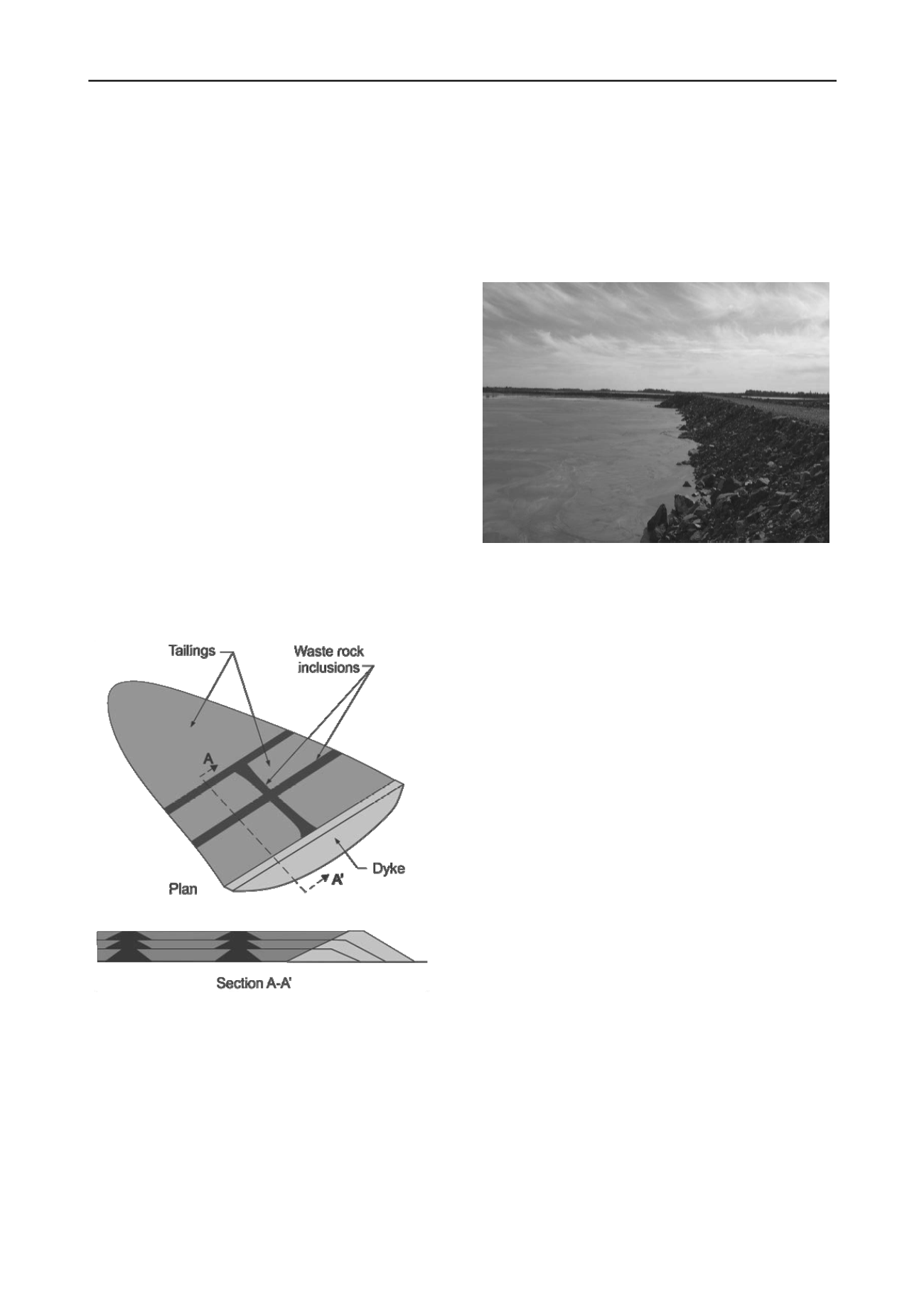
736
Proceedings of the 18
th
International Conference on Soil Mechanics and Geotechnical Engineering, Paris 2013
static liquefaction (Aubertin et al. 2002a; James 2009; Azam
and Li, 2010).
The release of tailings following the failure of an
impoundment is the one of the most serious risks associated
with mining and historically has caused numerous fatalities and
enormous environmental damage (ICOLD 2001).
2.2
Waste Rock
Waste rock, the silt to boulder size particles of broken rock
excavated to access ore, is a byproduct of mining. It may be
chemically inert or reactive, depending on the mineral
composition. In any event, it must be stored safely and
indefinitely at a reasonable cost. The grain size distribution of
waste rock generally falls in the range shown on Figure 1. The
gradation of waste rock results in a permeable material with a
relatively high stiffness and frictional strength. In geotechnical
terms, waste rock can be considered as rockfill.
3 WASTE ROCK INCLUSIONS
The construction of a tailings impoundment with waste rock
inclusions would proceed as follows: a) construction of the
starter dyke; b) placement of a thin layer of waste rock on the
bottom and sides of the impoundment; c) placement of waste
rock along pre-designated routes within the impoundment (local
heaps can also be placed – not shown here); d) hydraulic
deposition of tailings. For each stage of raising of the dyke, the
placement of additional waste rock on top of the existing
inclusions is followed by tailings deposition.
The resulting configuration of the impoundment with
inclusions is shown schematically on Fig 2.
Figure 2. Schematic representation of a tailings impoundment with
waste rock inclusions.
The basic premises of the method are that the waste rock being
more permeable and stronger than the tailings would accelerate
drainage and thus consolidation of the tailings, while providing
some physical reinforcement of the tailings. This is somewhat
similar to the use of gravel columns in deposits of soft clay or
silt for consolidation and reinforcement (Adalier et al. 2003).
The expected benefits of waste rock inclusions include
accelerated consolidation and compartmentalization of the
tailings, increased stability of the impoundment, and secure
placement of waste rock in the impoundment, additional waste
management options, and additional closure options.
Two issues which must be addressed are the infiltration of
the tailings into the waste rock and the ability of the tailings to
support the successive stages of waste rock placement. These
are discussed later in this paper.
Waste rock inclusions are currently being used at a gold
mine in western Quebec to help manage the tailings and
accelerate their consolidation. Figure 3 is photograph of an
inclusion at the mine. Surveillance and in situ testing of the
performance of these inclusions is ongoing.
Figure 3. A waste rock inclusion in a tailings impoundment at a mine in
western Quebec.
4 WASTE MANGEMENT AND CONSOLIDATION
Depending on the respective volumes of tailings and waste rock
produced, using waste rock inclusions could allow much of the
latter to be placed in the impoundment and eventually
submerged, significantly reducing the potential for AMD and
possibly eliminating the need for a separate disposal facility for
the waste rock. In some instances the reactive waste rock could
be used to form inclusions, which will remain submerged, while
the nonreactive waste rock is stored conventionally in piles.
Tailings could be discharged from conduit on the top of the
inclusions (as is done at the above mentioned mine), as well as
on the crest of the dyke, allowing for a more even distribution
of the tailings within the impoundment. In wide impoundments
this would result in additional volume for storage and more
flexible placement schemes.
The hydraulic conductivity of waste rock allows the
inclusions to act as drains within the tailings, accelerating
consolidation which leads to more rapid strength gain and
liberates more water which may be reused at the site. Parametric
numerical modeling of tailings consolidation with and without
waste rock inclusions by Jaouhar (2012) and Bolduc (2012)
indicates that waste rock inclusions can lead to a significant
increase in the rate of consolidation, depending on the spacing
of the inclusions, the thickness of the deposit, and the hydraulic
conductivity of the tailings. The accelerated rate of
consolidation is due to the reduced length of drainage paths
within the tailings as shown on Figure 4.
There can be some infiltration of the tailings into the waste
rock during placement and consolidation. The grain size
distribution of the waste rock tends to be highly heterogeneous,
in part due to segregation during transportation and placement.
Based on field observations at the site where inclusions have
been installed, many drainage pathways remain viable despite
the infiltration of tailings. Laboratory testing of the effect of
tailings infiltration on the flow through waste rock is currently
underway.
With respect to the stability of the inclusions within the
impoundment, the consolidation of the adjacent drained tailings


